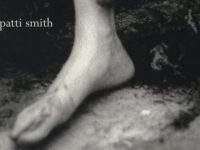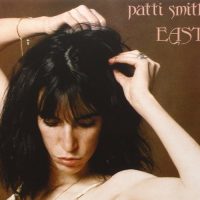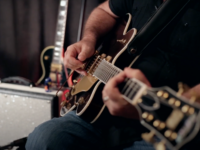photo: Annie Liebowitz/Arista Records
Remember when Patti Smith used to be considered dangerous?
It’s a little hard to reconcile the one-time high priestess of punk rock — the same one responsible for such edgy slices of punk poetry, and the subject of Gilda Radner’s dead-on Saturday Night Live character Candi Slice in the seventies — with the modern day Patti Smith. Today, Patti Smith has settled quite comfortably into her current role, as kind of a torch-bearing, elder-statesman figure, proudly waving the twin flags of her updated brand of bohemian beat-poetry and a modern-day sort of rock and roll literacy.
Patti Smith’s new album Banga may not deliver quite the same punk-rock snarl as her seventies classics Horses and Easter, but it is easily her best work since then. Like those amazing albums, Banga seamlessly places Smith’s spoken word, stream of consciousness poetry, within the more traditional context of three and four minute rock and roll song structures.
Well, mostly anyway.
On the sprawling, ten minute epic “Constantine’s Dream” — inspired by Piero della Francesca’s apocalyptic painting in the Basilica of St. Francis — Patti Smith weaves religious images of St. Francis and the angels, with visions of Constantine and his warrior conquistadors, all caught up together in some environmental apocalypse. Recited over a simple dirge-like musical backdrop that slowly builds to a wall of sound climax of discordant guitars and cacophonous noise, “Constantine’s Dream” is in many ways, the sort of wild, sonic freak-out that harkens back to her earlier ground-breaking tone-poems “Land,” “Birdland” and “Radio Ethiopia.” This is exactly the same wildly, improvisational sort of thing that gained Patti Smith her well-earned reputation as a great poetic voice that ultimately transcended the punk-rock medium she first got her start with.
Interestingly, on this album Patti Smith follows the epic “Constantine” with a gorgeous cover of Neil Young’s “After The Gold Rush” — a song with considerable apocalypse imagery of its own. It’s a great choice, as the two differing visions of rock and roll prophecy form a perfect compliment to one another. This isn’t the first time Patti Smith has covered Neil Young, either. Her version of “Helpless” is one of the many highlights on her 2007 album, Twelve, which finds Patti Smith covering artists ranging from Young and Dylan, to Cobain and Hendrix. Here, the addition of a children’s choir on the chorus lends an eerily haunting quality to Young’s lyrics about a future environmental doomsday.
Of course, any Patti Smith album worth its salt is going to contain lots of literary influences. In addition to “Constantine,” the opening “Amerigo” imagines what it might have been like if our country’s namesake Amerigo Vespucci made his voyage to discover America today. Likewise, the title track references the book, The Master and Marguerita by Mikel Bulgakov, and specifically a certain dog from the book (that’s Patti’s son Jackson you can hear making the dog yelps in the background). This song also features Johnny Depp playing guitar and drums. There is another song on Banga called “Nine” that Patti Smith wrote as a birthday gift to Depp. It is one of two songs on the album featuring a guitar solo from the great Tom Verlaine.
But not everything is a history lesson on Banga.
On the beautiful, “This Is The Girl,” Patti Smith pays tribute to the tortured soul of Amy Winehouse (“a song we wish we never had to write” she says in the liner notes). “Just a dark smear masking the eyes, spirited away buried in sighs,” Patti sings about Winehouse, as Lenny Kaye and Jackson Smith create the sort of spooky sounding, last-call guitar sounds that recall David Lynch’s torchy Twin Peaks soundtrack, and it’s chanteuse Julee Cruise. “Fuji-San” offers up a prayer to the great mountain for the people of Japan following last year’s devastating earthquake. It is also one of the better rock tracks on this album, featuring stellar performances from Smith’s longtime collaborator Lenny Kaye and the rest of her band, and a great solo from Jack Petruzzelli.
Like all of Patti Smith’s greatest work, Banga is an album that wears its literary influences on its sleeve, while weaving wildly between improvisational, avant-garde pieces like the Sun-Ra backed “Tarkovsky (The Second Stop Is Jupiter),” and more traditional fare like “This Is The Girl” and “April Fool.” Perhaps the biggest difference here though is Patti Smith’s voice. While her credentials as a great poet and writer have never really been in question, some have found Patti Smith’s vocals to be an acquired taste over the years. Banga is an album that finds Patti Smith to be a vocalist not only singing with more confidence than ever before, but also with surprising range.
Banga may not carry quite the same snarl as Patti Smith did in her punk rock days on albums like Easter and her still unequaled debut masterpiece Horses. But this is easily her best record in many a moon. Out June 5.
[amazon_enhanced asin=”1617130370″ /] [amazon_enhanced asin=”B007PVHBHC” /] [amazon_enhanced asin=”B007U2ABXM” /] [amazon_enhanced asin=”B000002VQQ” /] [amazon_enhanced asin=”B0057FWSQ2″ /] [amazon_enhanced asin=”B000002VQP” /] [amazon_enhanced asin=”B002HMHR8W” /] [amazon_enhanced asin=”B000002VQO” /]
- Pink Floyd – The Story Of 'Wish You Were Here' (2012) - June 29, 2012
- 'Neil Young FAQ' Diaries: On the Beach, Now and Then and the Kershaw Connection - June 15, 2012
- The Rockologist: The Raconteurs – Live At Montreux (2012) - June 8, 2012




